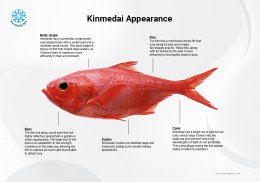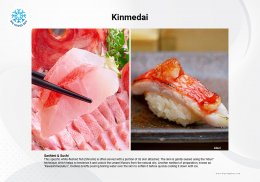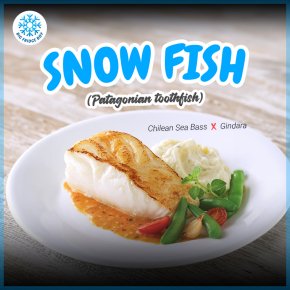What is Kinmedai (Golden Eye Snapper) ?
Last updated: 26 Apr 2023 | 7007 Views |
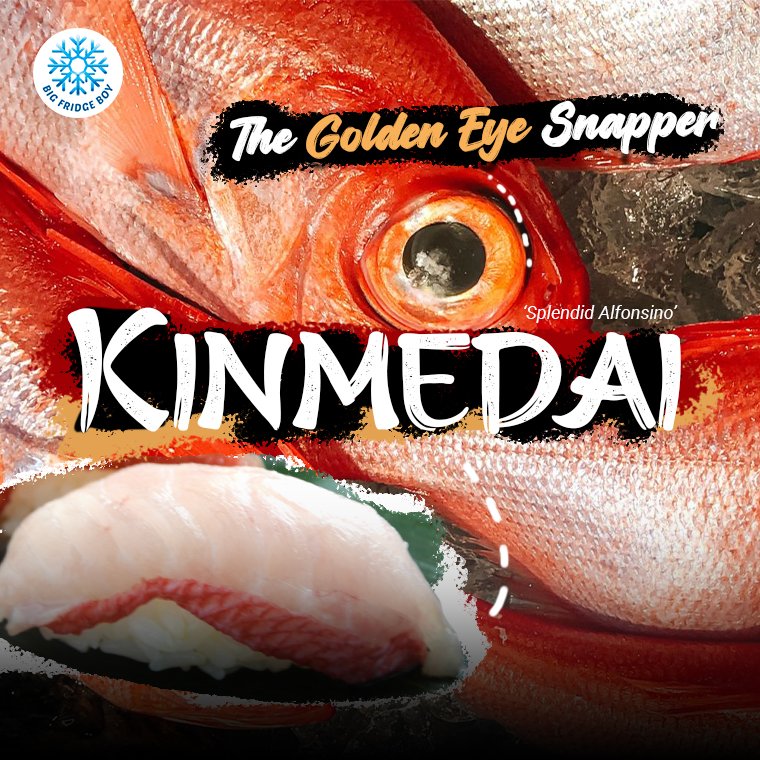
Kinmedai, also known as Splendid Alfonsino or Golden Eye Snapper, is a species of fish belonging to the family Berycidae. Its scientific name is ‘Beryx splendens’. Kinmedai is found in deep waters of the Atlantic, Indian, and Pacific Oceans, typically at depths of 200 to 800 meters. Most Kinmedai in the market are caught in the wild through deep-sea fishing methods.
This fish is known for its bright red color, large eyes, and a relatively small mouth. A typical adult specimen will measure 12 inches in length, but can grow to 2 feet. It is most commonly fished in the waters south of Tokyo, particularly in Kanagawa and Shizuoka prefectures.
Kinmedai is highly prized in Japanese cuisine for its tender, white flesh with a delicate flavor and a slightly sweet taste. It is often served as sushi, sashimi, or in various cooked dishes. The fish is especially popular in high-end restaurants, where it is considered a delicacy.
Kinmedai in Japanese is written as 金目鯛. The three kanji characters represent the following:
- 金 (kin) means "gold" or "golden."
- 目 (me) means "eye."
- 鯛 (dai) means "snapper" or "seabream."
Together, 金目鯛 (Kinmedai) refers to the golden-eyed snapper, reflecting the fish's striking appearance and large, shiny eyes.
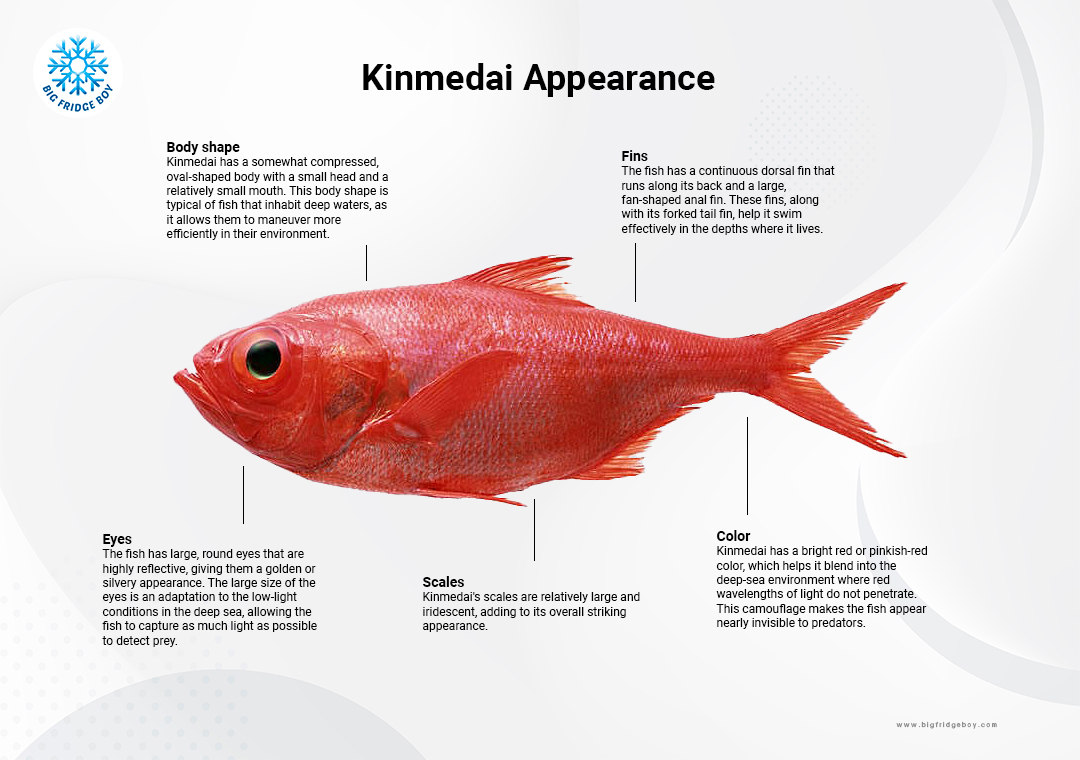
Appearance
- Color
Kinmedai has a bright red or pinkish-red color, which helps it blend into the deep-sea environment where red wavelengths of light do not penetrate. This camouflage makes the fish appear nearly invisible to predators. - Eyes
The fish has large, round eyes that are highly reflective, giving them a golden or silvery appearance. The large size of the eyes is an adaptation to the low-light conditions in the deep sea, allowing the fish to capture as much light as possible to detect prey. - Body shape
Kinmedai has a somewhat compressed, oval-shaped body with a small head and a relatively small mouth. This body shape is typical of fish that inhabit deep waters, as it allows them to maneuver more efficiently in their environment. - Fins
The fish has a continuous dorsal fin that runs along its back and a large, fan-shaped anal fin. These fins, along with its forked tail fin, help it swim effectively in the depths where it lives. - Scales
Kinmedai's scales are relatively large and iridescent, adding to its overall striking appearance.
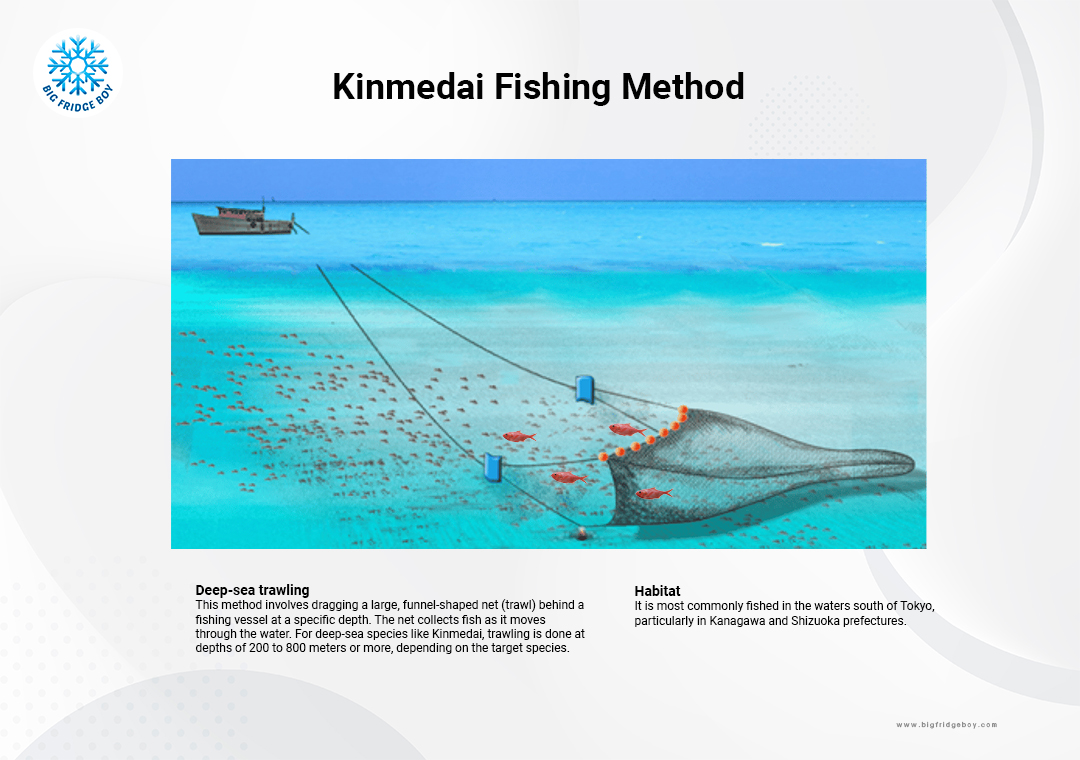
Fishing Method
Catching deep-sea fish like Kinmedai can be more challenging than fishing for species that live closer to the surface. However, commercial fishing methods have been developed to target deep-dwelling fish
- Deep-sea trawling
This method involves dragging a large, funnel-shaped net (trawl) behind a fishing vessel at a specific depth. The net collects fish as it moves through the water. For deep-sea species like Kinmedai, trawling is done at depths of 200 to 800 meters or more, depending on the target species.

Cooking Method
This specific white-fleshed fish (Shiromi) is often served with a portion of its skin attached. The skin is gently seared using the "Aburi" technique, which helps to tenderize it and unlock the umami flavors from the natural oils. Another method of preparation, known as "Kawashimozukuri", involves briefly pouring boiling water over the skin to soften it before quickly cooling it down with ice.
- Shiromi (白身)
Shiromi is a Japanese term used to describe white-fleshed fish, which are often used in sushi and sashimi dishes. The word "shiromi" literally translates to "white body" or "white flesh" in English. These fish typically have a lighter, more delicate flavor and a tender texture compared to their counterparts with darker, oilier flesh, like tuna or salmon.
Shiromi is commonly used in Japanese cuisine for its clean taste and versatility, making it an ideal choice for various preparations, including raw, cooked, and marinated dishes. Some examples of shiromi fish include sea bream (madai), flounder (hirame), snapper (tai), and, as previously mentioned, kinmedai (golden eye snapper). - Aburi (炙り)
Aburi is a Japanese cooking technique that involves partially searing or torching the surface of food, particularly fish, to add flavor and texture. The word "Aburi" comes from the verb "aburu," which means "to roast" or "to grill" in Japanese. In sushi and sashimi dishes, Aburi is commonly used with fish such as salmon, tuna, and other types of white-fleshed fish like kinmedai.
The Aburi method creates a unique contrast between the lightly seared outer surface and the raw or partially cooked interior of the fish. This process enhances the overall flavor of the dish, as it brings out the natural oils and umami flavors, while also adding a subtle smoky taste and a slightly firmer texture to the exterior. Aburi-style sushi and sashimi have gained popularity in recent years due to their unique combination of flavors and textures. - Kawashimozukuri
Kawashimozukuri is a Japanese culinary technique used for preparing fish, particularly for sushi and sashimi dishes. In this method, the fish's skin is briefly exposed to boiling water, which helps to tenderize it and remove any sliminess. Immediately after this process, the fish is quickly chilled with ice or cold water to stop the cooking and preserve the freshness and delicate texture of the flesh.
The Kawashimozukuri technique is often used with white-fleshed fish like kinmedai and other types of shiromi. This method not only enhances the fish's overall texture, but it also helps to bring out the natural flavors and umami characteristics of the skin, making the dish even more delicious and enjoyable.
Both techniques aim to enhance the fish's delicate texture and rich taste.
Best season to consume
The best season to consume Kinmedai is typically from late winter to early spring, which usually falls between February and April. During this time, the fish has a higher fat content, giving its flesh a richer flavor and a more desirable texture. The increased fat content is a result of the fish storing energy in preparation for spawning, making it more delicious and sought-after during this period.
While Kinmedai can be found and consumed year-round, it is considered to be at its peak in taste and quality during these months. This is when you will most likely find it featured in high-end sushi restaurants and other establishments that serve Japanese cuisine.
The rarity and exceptional taste of Kinmedai make it a sought-after ingredient in high-end sushi and sashimi dishes. Overall, Kinmedai is a remarkable and unique fish that holds a special place in the world of seafood and Japanese cuisine.

